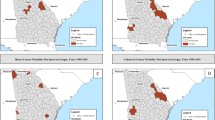Abstract
Objectives: We used readily accessible, existing data to assess whether or not geographic variation in breast cancer incidence rates in the San Francisco Bay Area was related to the unequal distribution of known breast cancer risk factors.
Methods: Cancer registry and 1990 census block-group data were used to look at the associations between breast cancer incidence and known risk factors (including parity, urban/rural status, and socioeconomic indicators) in 25 California counties. Average annual age-adjusted invasive breast cancer incidence rates were calculated for the period 1988-1992, and adjusted morbidity ratios were computed.
Results: While breast cancer incidence in Marin County was 9 percent higher than that of the other 24 counties combined (relative risk=1.09, 95 percent confidence interval=1.01-1.18), this increase appeared to be due to the unequal distribution of known risk factors. Block-groups that had a high level of any risk factor had higher incidence rates, regardless of geographic location. After multivariate adjustment, breast cancer incidence no longer differed between Marin and the other counties (adjusted morbidity ratio=1.02).
Conclusions: The results suggest that the unequal distribution of known risk factors was responsible for Marin County's high breast cancer incidence rate.
Similar content being viewed by others
References
Kosary CL, Ries LAG, Miller BA, Hankey BF, Harras A, Edwards BK, eds. SEER Cancer Statistics Review, 1973-1992: Tables and Graphs, National Cancer Institute. NIH Pub. No. 96-2789. Bethesda, MD, 1995.
Glaser SL, Satariano ER, Leung RW, Prehn AW, Cady CM, West DW, eds. Cancer Incidence by Race/Ethnicity in the San Francisco Bay Area: Twenty years of cancer reporting, 1973-1992. Union City, CA: Northern California Cancer Center, 1995.
Bureau of the Census. Census of Population and Housing, 1990: Summary Tape File 3 on CD-ROM (machine-readable data files). Washington, DC: Bureau of the Census, 1992.
Madigan MP, Ziegler RG, Benichou J, Byrne C, Hoover RN. Proportion of breast cancer cases in the United States explained by well-established risk factors. J Natl Cancer Inst 1995; 87: 1681–5.
Bruzzi P, Green SB, Byar DP, Brinton LA, Schairer C. Estimating the population attributable risk for multiple risk factors using case-control data. Am J Epidemiol 1985; 122: 904–14.
Robbins AS, Brescianini S, Kelsey JL. Regional differences in known risk factors and the higher incidence of breast cancer in San Francisco. J Natl Cancer Inst 1997; 89: 960–5.
Krieger N. Overcoming the absence of socioeconomic data in medical records: validation and application of a census-based methodology. Am J Public Health 1992; 82: 703–10.
Kelsey JL. Breast cancer epidemiology: summary and future directions. Epidemiol Rev 1993; 15: 256–63.
Krieger N. Women and social class; a methodological study comparing individual, household, and census measures as predictors of black/white differences in reproductive history. J Epidemiol Comm Health 1991; 45: 35–42.
Breslow NE, Day NE. Statistical Methods in Cancer Research: Volume 1-The Analysis of Case-Control Studies. IARC Scientific Pub. No. 32. Lyon, France: International Agency for Research on Cancer, 1980.
US Department of Commerce, Bureau of the Census. Census of Population and Housing, 1970: General Population Characteristics, Final Report PC (1)-B. Washington, DC: The Bureau of the Census.
Dean AG, Imrey HH, Dusich K, Hall WN. Adjusting morbidity ratios in two communities using risk factor prevalence in cases. Am J Epidemiol 1988; 127: 654–62.
Sturgeon SR, Schairer C, Gail M, McAdams M, Brinton LA, Hoover RN. Geographic variation in mortality from breast cancer among white women in the United States. J Natl Cancer Inst 1995; 87: 1846–53.
Laden F, Spiegelman D, Neas LM, et al. Geographic variation in breast cancer incidence rates in a cohort of US women. J Natl Cancer Inst 1997; 89: 1373–8.
Greenwald HP, Polissar NL, Borgatta EF, McCorkle R. Detecting survival effects of socioeconomic status: problems in the use of aggregate measures. J Clin Epidemiol 1994; 47: 903–9.
Susser M. The logic in ecological: II. The logic of design. Am J Public Health 1994; 84: 830–5.
Safe HS. Xenoestrogens and breast cancer. N Engl J Med 1997; 337: 1303–4.
Author information
Authors and Affiliations
Rights and permissions
About this article
Cite this article
Prehn, A.W., West, D.W. Evaluating local differences in breast cancer incidence rates: A census-based methodology (United States). Cancer Causes Control 9, 511–517 (1998). https://doi.org/10.1023/A:1008809819218
Issue Date:
DOI: https://doi.org/10.1023/A:1008809819218




